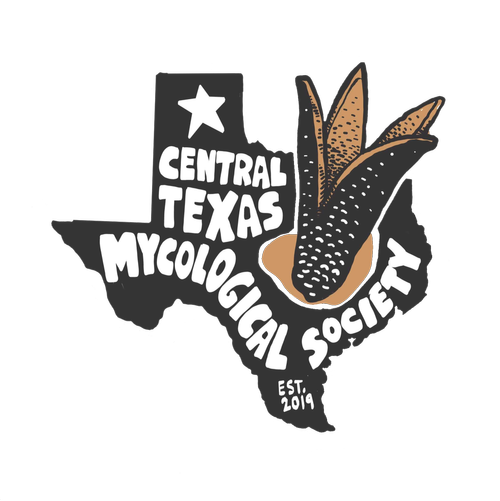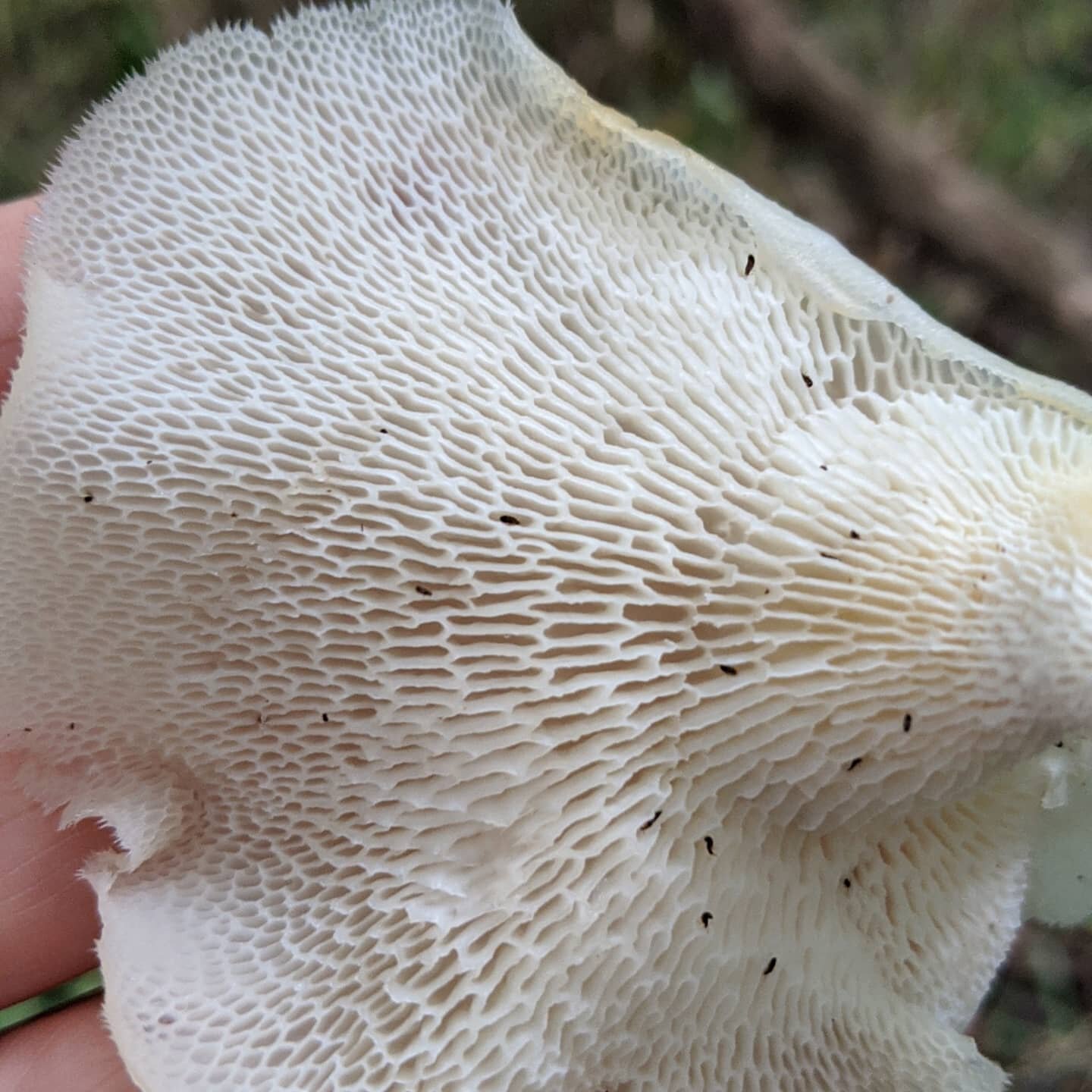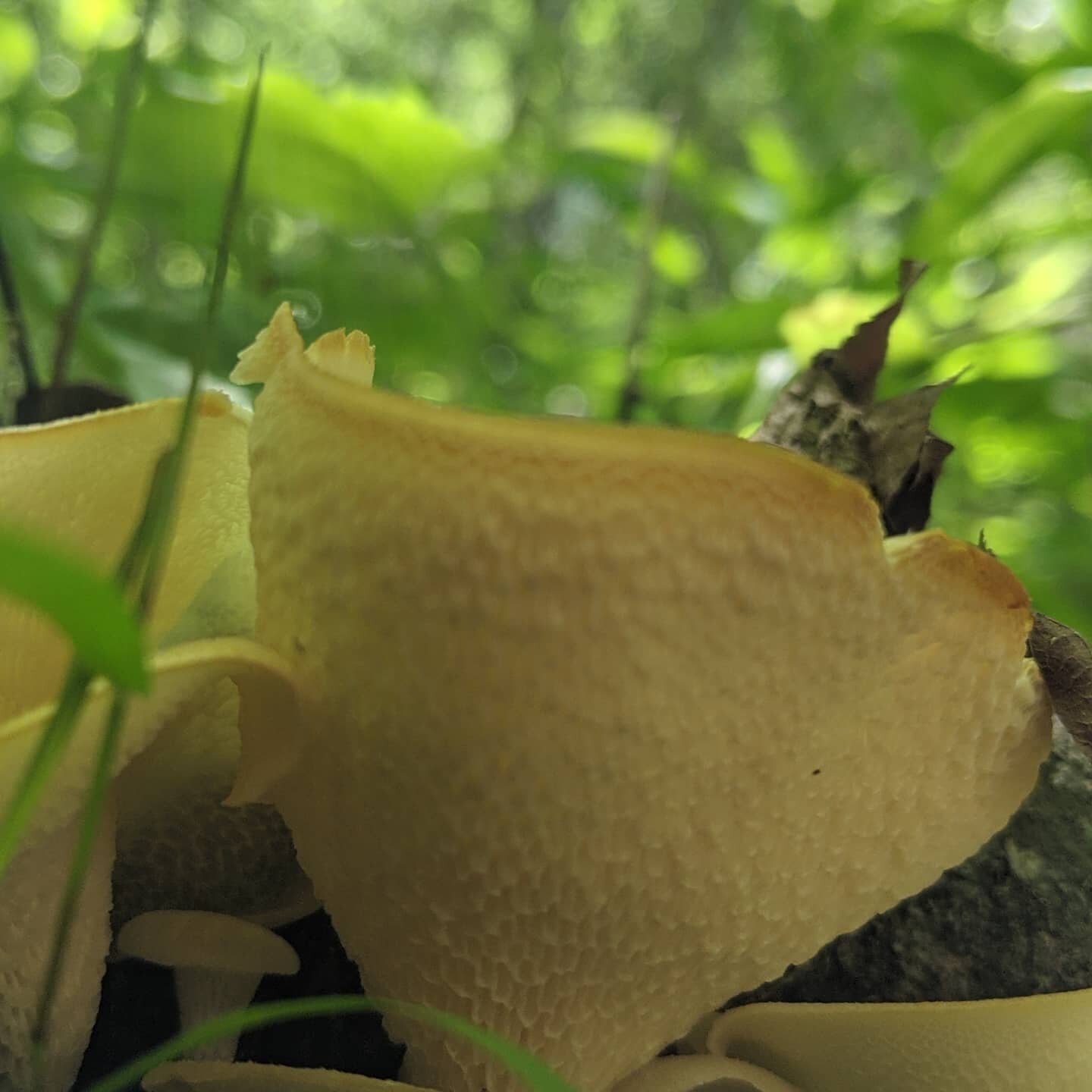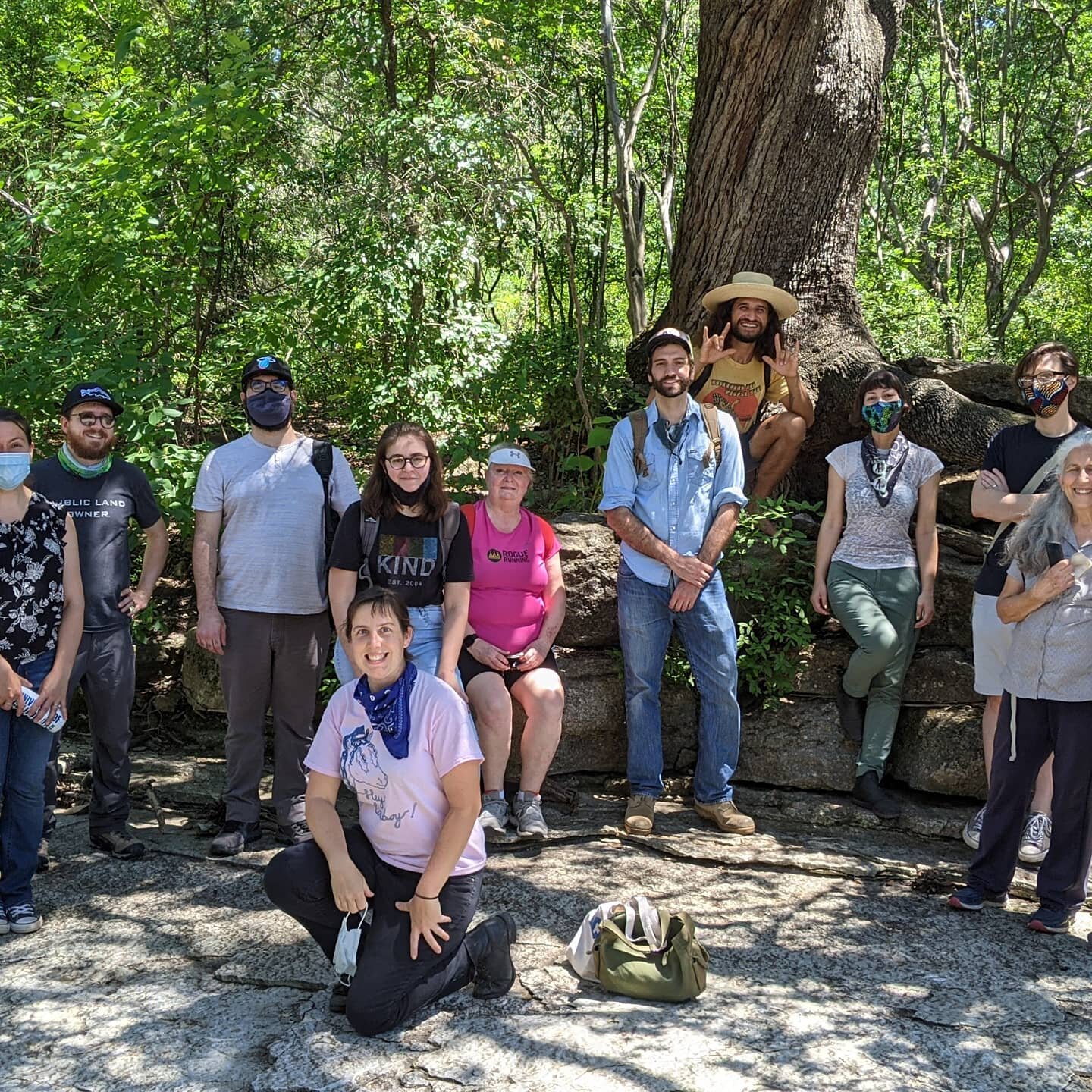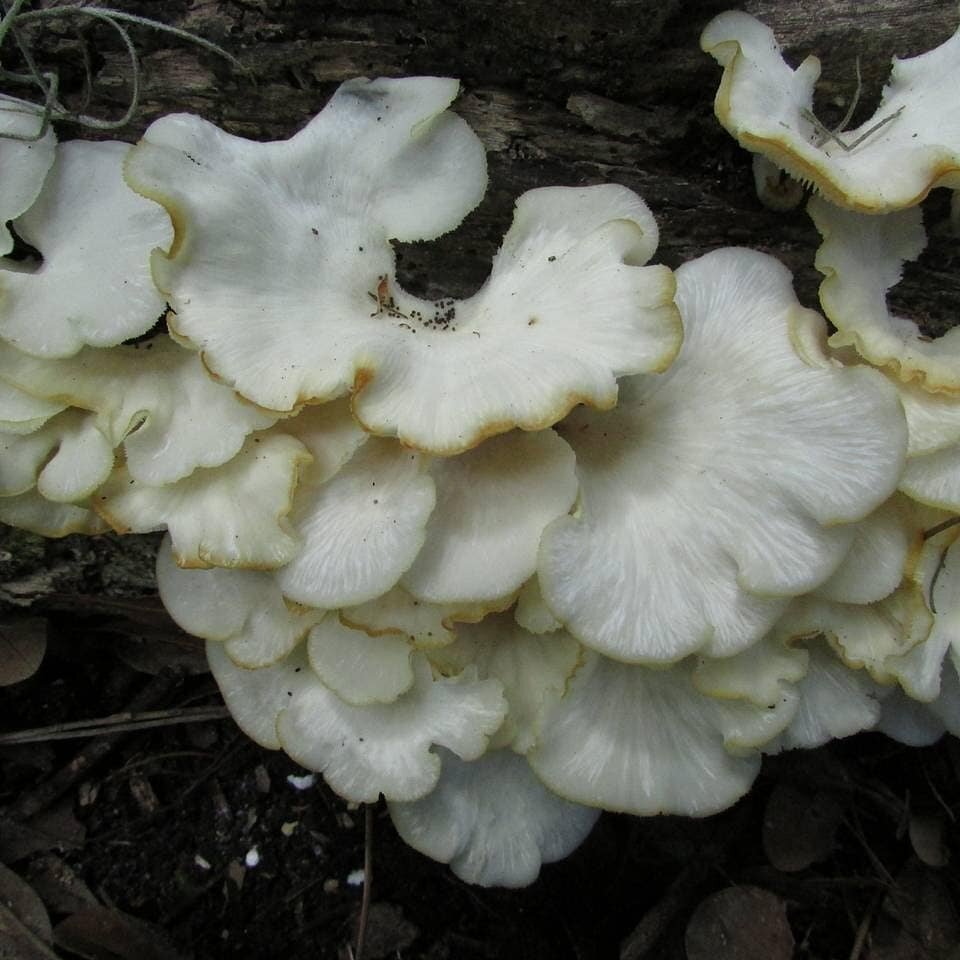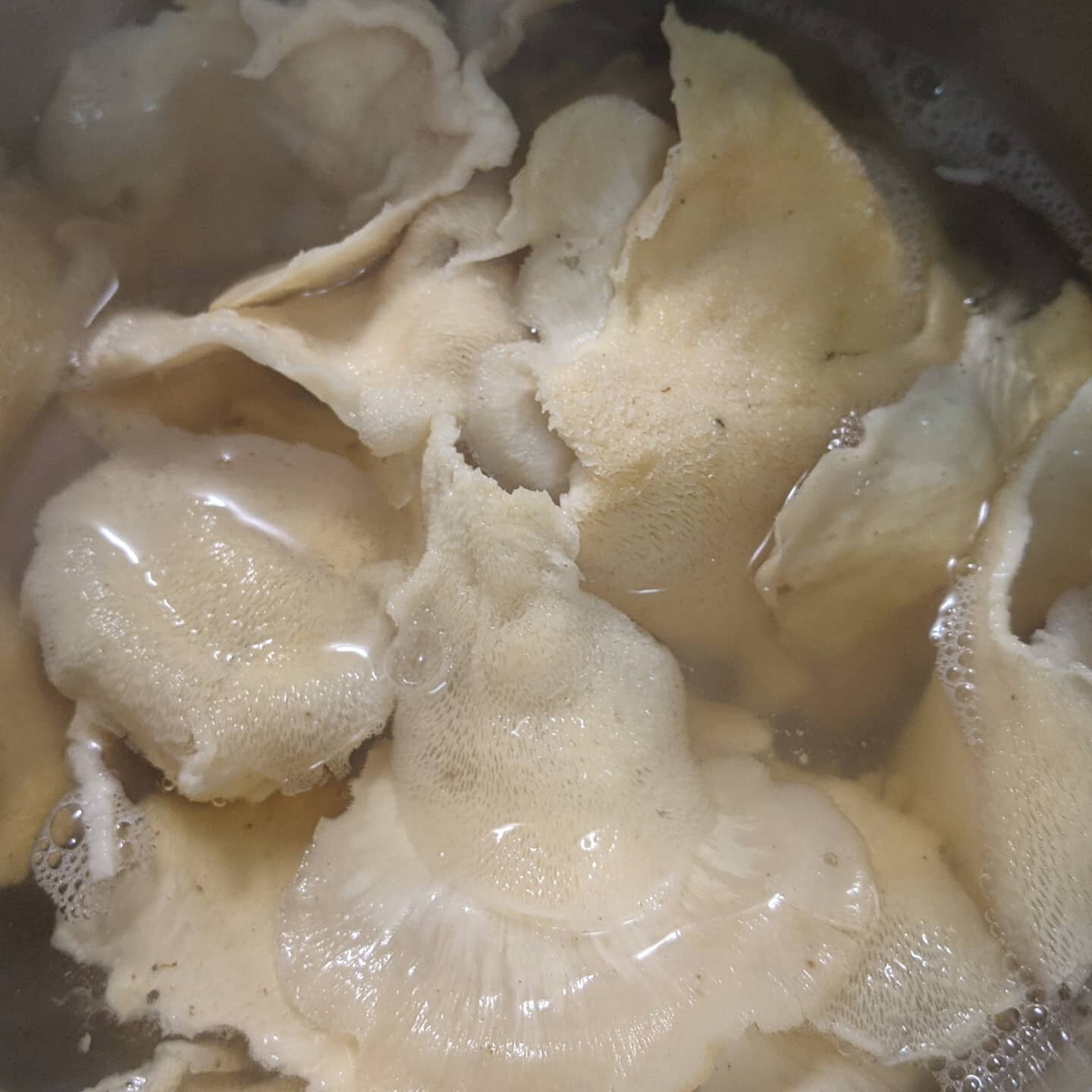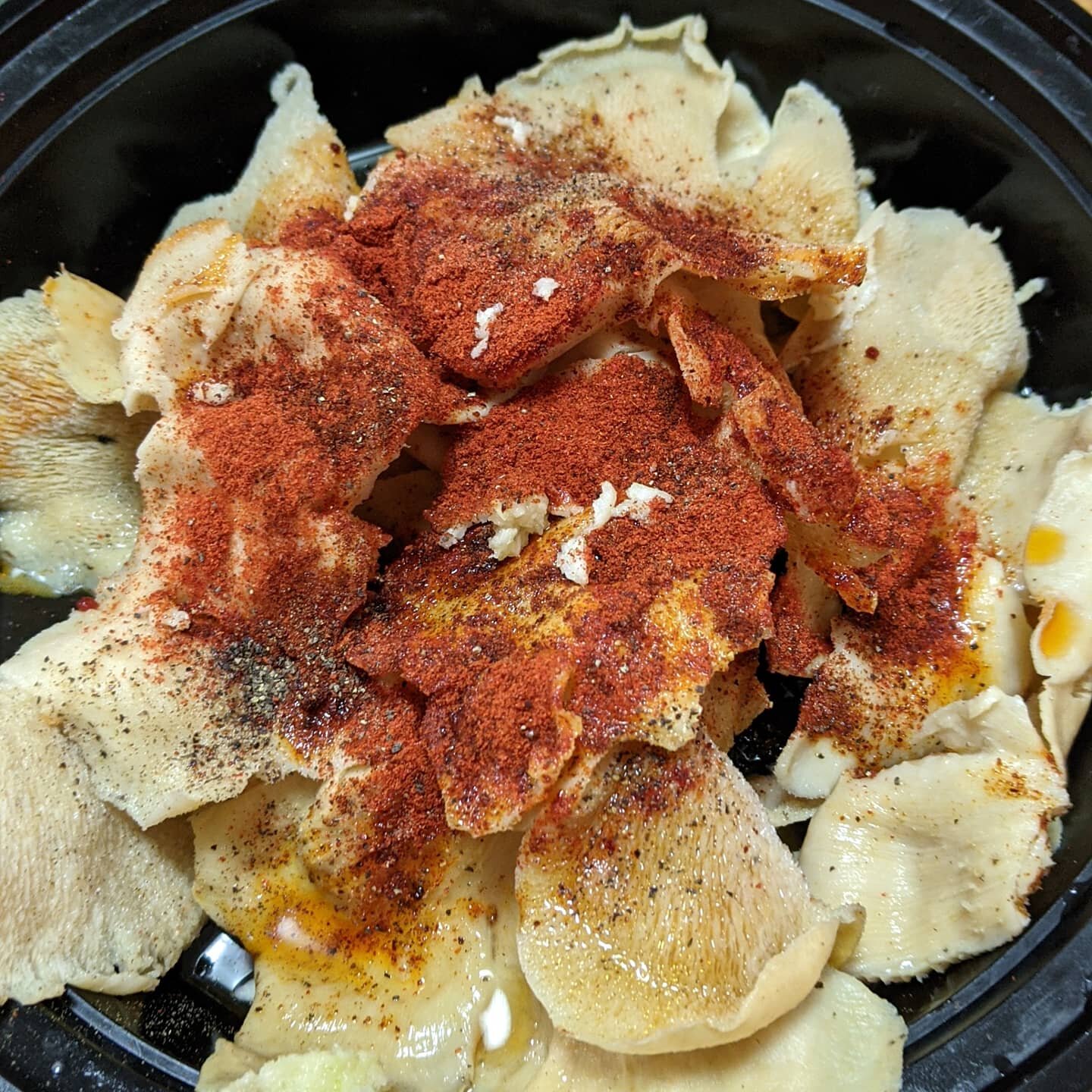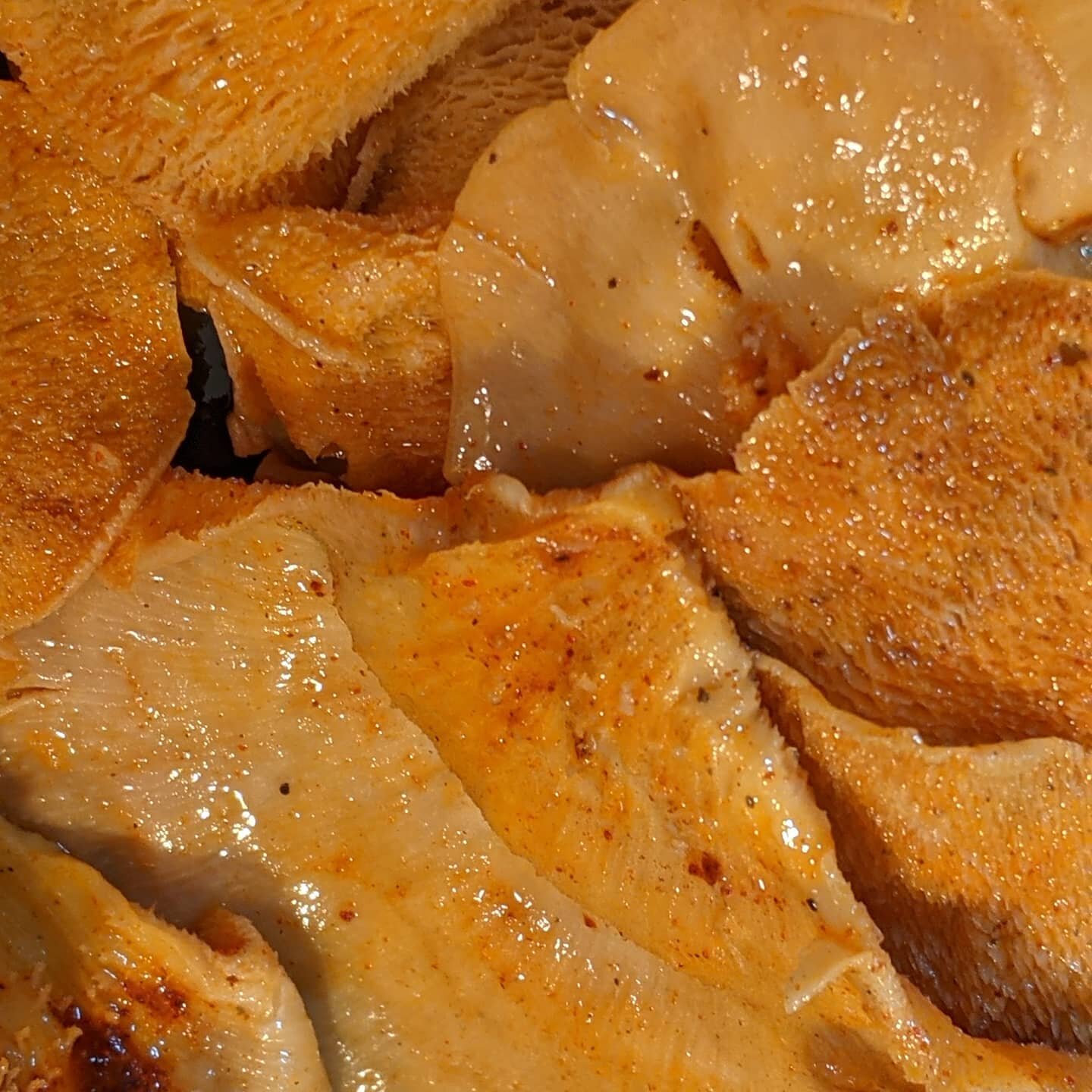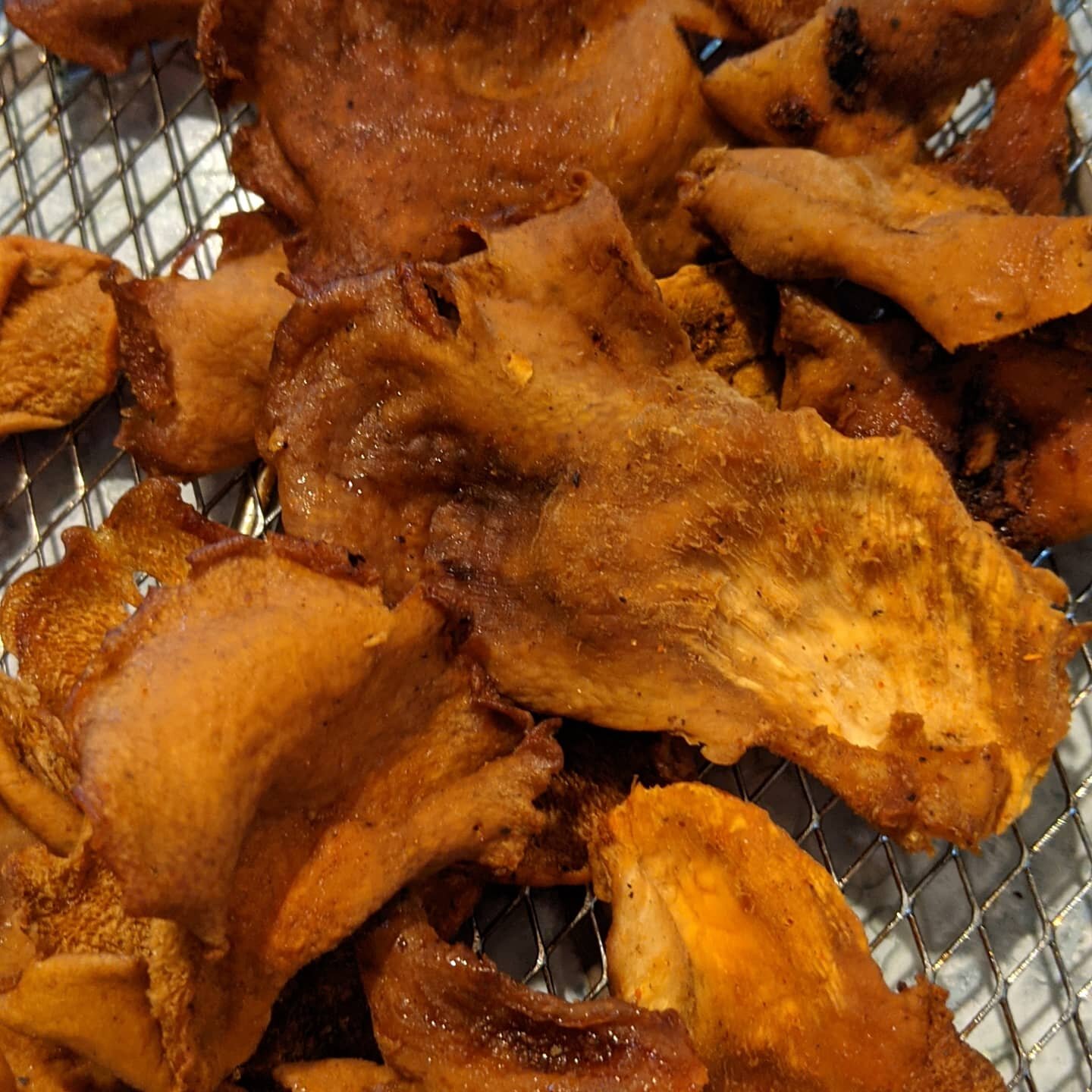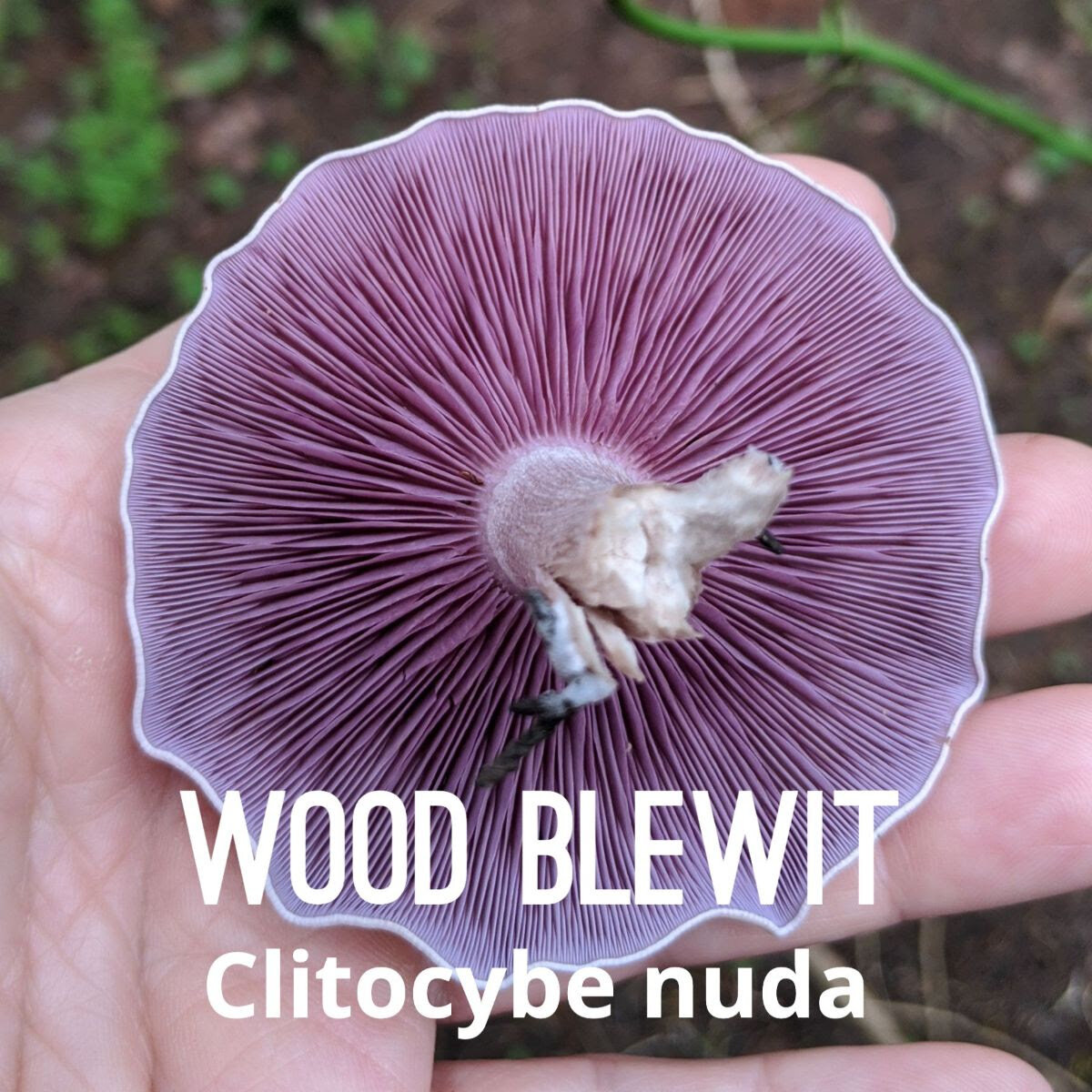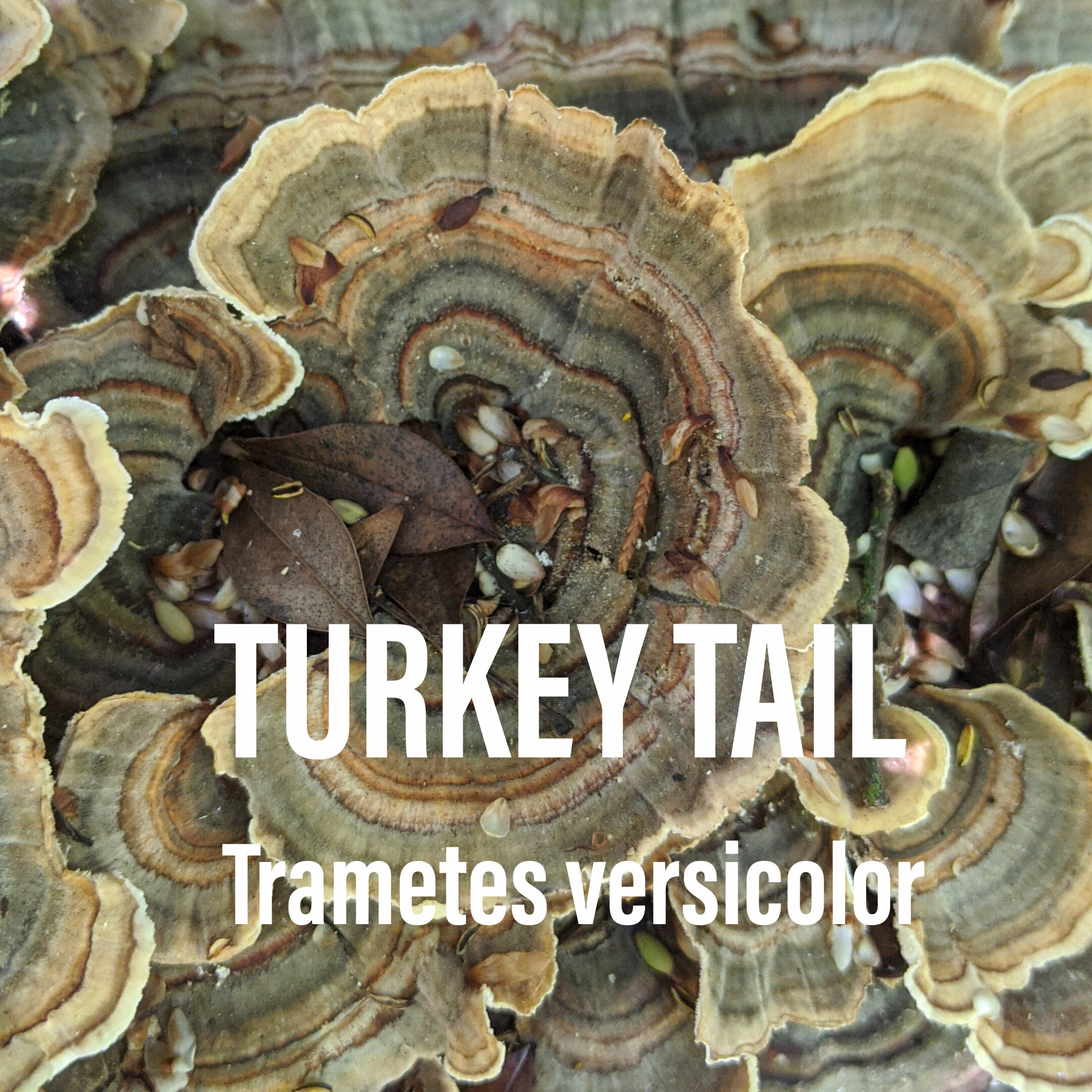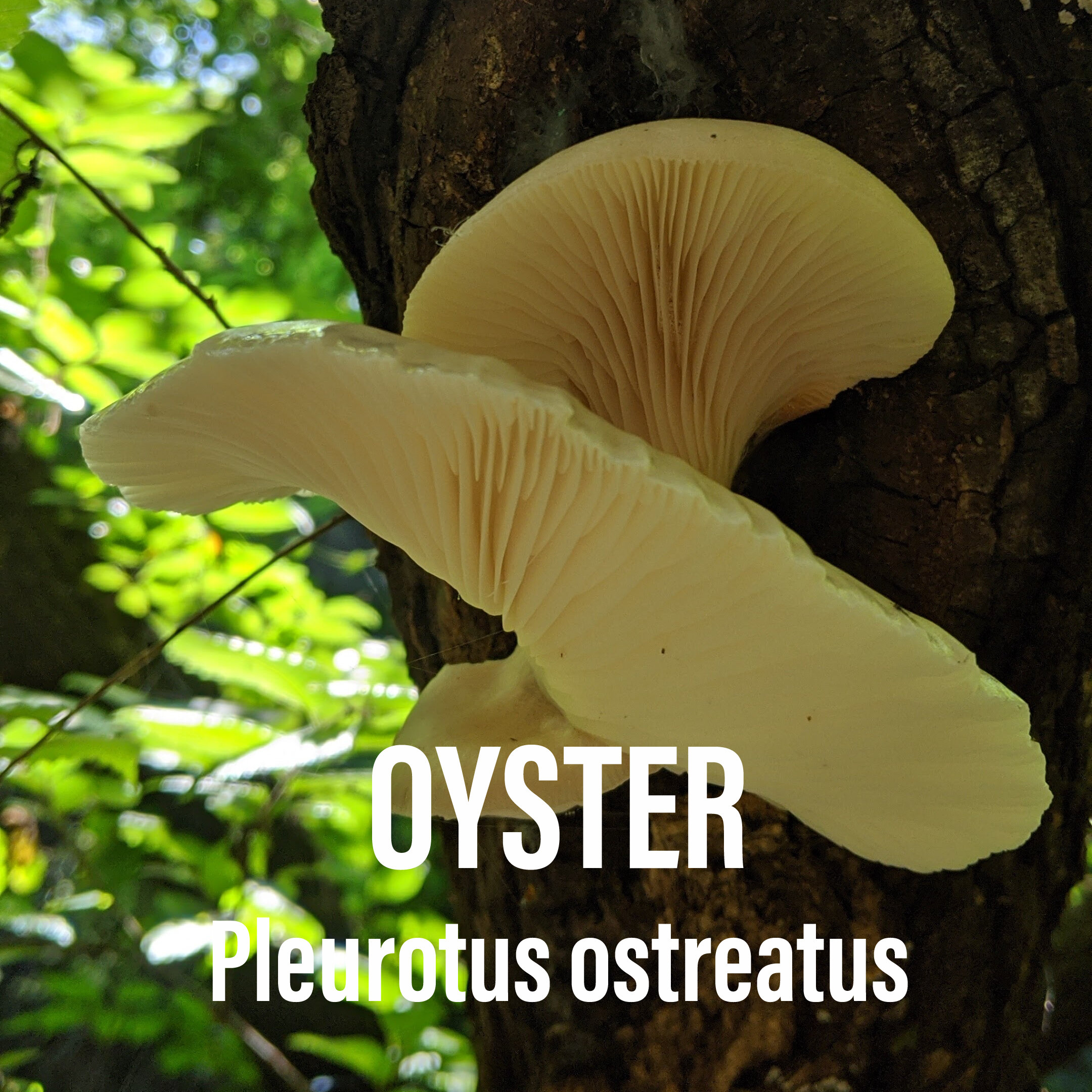Foraging and Cooking the Honeycomb Fungus, Favolus
by @forage.atx
I tried a new recipe with a tropical honeycomb fungus or Favolus (teniculus or brasiliensis sp.?). As things start to heat up they flush after a good rain. We spotted a flush on what appeared to be a dying root on the last Centra lTexas Mycology foray but they were older, yellowing, and already being enjoyed by the bugs. Yvonne and Josh gifted me a large amount they spotted a few days prior. 🙏 It's not a choice edible mostly because of the texture and there is not much information on the edibility of this mushroom online. I've eaten them for several years and they take on a chip-like quality and absorb flavor really well because of the shape of their gills.
In 2020 a paper was published on the commercial cultivation, nutrition and food potential of this tropical mushroom in the Amazon where it is native and collected by the Yanomami people, who already sell more than 10 Amazon mushroom species. You can learn more about their mushroom culture in this film by @beatrizmaues.
"The mushrooms collected in the study present an average of 7.4% humidity, 27% crude protein, 1.5% ether extract, 17% crude fiber, and 1.7% mineral matter. Compared with other species of edible mushrooms, both wild and cultivated, the moisture content of F. brasiliensis (7.40%) is low for species of the genus Pleurotus. For example, the humidity varies from 87% to more than 90%, similar to that found in Lentinus crinitus, another mushroom native to Brazil and also consumed by the Yanomami people. Thus, F. brasiliensis has the potential to be used in human foods."
I tried a new tip I learned from Myers Mushrooms_eptx and I boiled them first. Andre does this for making oyster mushroom jerky. I then marinated in rice wine, smoked paprika, red pepper, black pepper, salt. I then air-fried at 140 for 6 hours. The result tasted has the texture of chicharrones or pigs ears! So many nutritional benefits and meat alternatives in mushrooms! 🪅
FAVOLUS! 🍄❣️
May Forage Forecast
There are a lot of different types of edible mushrooms poppin' off in May and after all the recent rain, the following are mushrooms to look out for in Central Texas. Click images to learn more and to see where to find them.
There are a lot of different types of edible mushrooms poppin' off in May and after all the recent rain, the following are mushrooms to look out for in Central Texas.
CHANTERELLE: Keep a look out for the popular edible mushroom Cantharellus. In Central Texas, they are symbiotic with older Texas Live Oaks trees that have a lot of leaf matter, making the ground spongy. Trees near creeks and where water is flowing is very important. Chanterelles need a lot of rain to fruit and they like the torrential Texas-style flash floods. They are orange, yellow or even white, meaty and funnel-shaped and can be found in clusters but most of the time they are found popping up as individual mushrooms as shown in the picture. On the lower surface, underneath the smooth cap, most species have rounded, forked folds that run almost all the way down the stipe, which tapers down seamlessly from the cap. Many species emit a fruity aroma, reminiscent of apricots, and often have a mildly peppery taste. The Jack-o-lantern, Omphalotus illudens is considered the false chanterelle in Texas so be sure to know the morphology and difference. They do sometimes grow around the same time of year but their habitat and morphology is different.
OYSTER: Continue to keep an eye out for Oyster Mushrooms, Pleurotus ostreatus grows on dead black willows and oaks along creeks and rivers.
WOOD EAR: In the Auricularia family and are an edible jelly fungus that pops up on downed hardwood limbs just a few days after a good rain. The fruiting body is distinguished by its noticeably ear-like shape and brown colouration which is because wood ears have more melanin which also helps protect them from harsh environments such as those found in areas of radiation exposure. All good things for taking a melfie.
A 2012 paper with the forbidding title Compton Scattering by Internal Shields Based on Melanin-Containing Mushrooms Provides Protection of Gastrointestinal Tract from Ionizing Radiation describes this work. The authors fed mice a wood ear mushrooms an hour before giving them a powerful 9 Gy dose with the beta emitter Cesium137. For perspective, anything over ~0.1 Gy is considered a dangerously high dose for humans. All the control mice died in 13 days while ~90% of the mushroom-fed ones survived. Mice fed a white mushroom (porcini) died almost as fast as the controls, but those fed white mushrooms supplemented with melanin also survived.
More recently, research from Northwestern University isolated the naturally occurring melanin from the fungal cells, etching biomaterials away and leaving a melanin-containing shell - "fungal ghosts" for their hollow, ghost-like quality.
Wood ears are grown commercially (not in Texas yet???) and are a popular ingredient in many Chinese dishes. I had them recently in a congee with 5 different foraged mushrooms.
They are also used in Chinese medicine. A soup containing the species is used medicinally for dealing with colds and fevers by reducing the heat of the body It is also used in Ghana as a blood tonic. Modern research into possible medical applications has variously concluded that wood ear has anti-tumor, hypoglycemic, anticoagulant and cholesterol-lowering properties.
RINGLESS HONEY MUSHROOMS: Desarmillaria tabescens pop up in the spring and fall in large clusters at the bases of dead or dying trees (when the clusters appear to be terrestrial they are actually growing from underground wood). This parasitic fungus is part of a genus that is the largest living organism ever found on this planet.
JACKSON'S SLENDER CAESAR Amanita jacksonii, or Jackson's Slender Caesar, is an edible mushroom found in oak and pine forests. They are more common in East Texas but they can be found in Central Texas. It is easy to spot with its brilliant red cap that fades from the outer edge to the center with age. The stem of the mushroom is yellow with orange fibrils. The cap of the mushroom can grow to 4 inches; oval at first, then becoming convex with a central bump. the gills are crowded, orange-yellow, and free from the stem. The flavor is of hazelnuts and chestnuts.
As always, if you are trying a new mushroom, confirm the ID with an expert, then try a small amount to make sure you don't have an allergic reaction. Texas Mushroom Identification Facebook group is great for quick responses and ID help. Also, don't forget to add your finds on the Mushrooms of Texas project on iNaturalist.
Follow my foraging adventures @forage.atx.
May Member Giveaway
Grow-your-own Lion’s Mane Kit from Hi-Fi-Myco
Hi-Fi Myco is Austin’s first urban mushroom farm. This month's member mushroom giveaway is the Blue Oyster, Pleurotus Ostreatus. The blue oyster mushroom grows in large clusters and takes on the typical shelf-like shape of the Pleurotus species. The size and shape can vary immensely depending on the growing conditions. All you need to do is spritz with water and the mushroom clusters start out with deep blue coloring and eventually turn grey as they age. The fruit is usually thick and meaty and very versatile for culinary uses. Oyster mushrooms also contain a plethora of valuable constituents like proteins, amino acids, antioxidants, vitamins and minerals. They are rich in vitamin B and vitamin D. Iron and potassium are also present in these mushrooms.
Kits and fresh mushrooms are available for purchase on their website for pick-up at the following Farmers Market's: Lakeline, Sunset Valley, Downtown, New Braunfels, and Mueller.
Become a member of CTMS and be entered in a win!
Winner will be announced in June.
PHOTOS: Zilker Mushroom Project, Spring Edition
Here are a few photos from spring foray in Zilker Park! We continued to observe and ID mushrooms for the Zilker Mushroom iNaturalist Project.
It was a humid day, perfect conditions for mushrooms and we didn't get out of the parking lot before seeing a Stalked Lattice Stinkhorn, Lysurusperi phragmoides. The only screams heard were from the stench and not a spontaneous orgasm.
Here are a few photos from spring foray in Zilker Park! We continued to observe and ID mushrooms for the Zilker Mushroom iNaturalist Project.
It was a humid day, perfect conditions for mushrooms and we didn't get out of the parking lot before seeing a Stalked Lattice Stinkhorn, Lysurusperi phragmoides. The only screams heard were from the stench and not a spontaneous orgasm.
FROM COLORADO.EDU:
"Flies are attracted to the cap of the mushroom by stinky compounds emanating from a thick slime that flies and other insects drink. But the slime is also a dense suspension of spores, which are single cells that serve the same function as seeds. Bees and beetles also eat the cap or gleba and inadvertently swallow spores. To insure spore dispersal, the slime has a potent laxative that induces flies to dribble tarry feces rich in spores, usually in close proximity to the stinkhorn."
Not only did we witness flies and beetles collecting spores, it was a treat to hear the biodata from the stinkhorn collected by @winkwinketc and @ornate_coleman for the upcoming Octopus Project audio-visual performance on May 1st. Tickets go on sale on April 15.
April Foraging Forecast
Shoehorn Oyster Mushrooms, Hohenbuehelia petaloides is distinctively shaped; its "petaloid" habit often makes it look like a shoehorn with gills, or a rolled-up funnel.
WOOD BLEWIT: Keep a look out for the edible Wood Blewit, Clitocybe Nuda. They also fruit after a freeze. This distinct lavender-colored mushroom is found in hardwood leaf litter and is a great decomposer. Be warned because there are deadly, poisonous look-alikes in the Cortinarius family that grow in similar conditions. It's important to do a spore print AND also confirm the ID with an expert. The spores of the wood blewit are light pink to white and the spores of Cortinarius mushrooms are rust colored. I wrote up a blog post with lots of photos and details to help you identify this mushroom.
Fresh wood blewits are great with eggs in breakfast tacos. As they get older they become more tan and iridescent colored on the cap and taste bitter. I throw the older wood blewits my compost leaf pile because they are such great decomposers and will colonize and grow in hardwood leaf litter.
SHOEHORN OYSTER: Shoehorn Oyster Mushrooms, Hohenbuehelia petaloides is distinctively shaped; its "petaloid" habit often makes it look like a shoehorn with gills, or a rolled-up funnel. Other identifying features include its fairly crowded whitish gills, a white spore print, mealy odor and taste—and, under the microscope, gorgeous "metuloids" (thick-walled pleurocystidia). It often appears in clusters in urban, semi-urban, or even household settings, and is frequently associated with woody debris (though it does not usually grow directly from dead wood) or cultivated soil. However, it can be found in woodland settings, too, where it tends to grow alone or in small groups.
TURKEY TAIL: The medicinal mushroom Turkey Tail, Trametes versicolor will also flush after rain on downed hardwood logs, stumps and, occasionally, on conifer wood. Make sure the underside is porous and white because it can look a lot like False turkey tail. Mushroom Expert has a useful check list to determine if it is true medicinal turkey tail.
WOOD EAR: Auricularia americana, an edible jelly fungus pops up on downed hardwood limbs a few days after a good rain. Wood ear mushrooms are a popular ingredient in many Chinese dishes such as hot and sour soup, and is also used in Chinese medicine. It is also used in Ghana as a blood tonic. Modern research into possible medical applications has variously concluded that wood ear has anti-tumor, hypoglycemic, anticoagulant and cholesterol-lowering properties.
As always, if you are trying a new mushroom, confirm the ID with an expert, then try a small amount to make sure you don't have an allergic reaction. Texas Mushroom Identification Facebook group is great for quick responses and ID help. Also, don't forget to add your finds on the Mushrooms of Texas project on iNaturalist.
Follow my foraging adventures @forage.atx.
April Member Giveaway
This month's member mushroom giveaway is the Blue Oyster, Pleurotus Ostreatus. The blue oyster mushroom grows in large clusters and takes on the typical shelf-like shape of the Pleurotus species.
Grow-your-own Lion’s Mane Kit from Hi-Fi-Myco
Hi-Fi Myco is Austin’s first urban mushroom farm. This month's member mushroom giveaway is the Blue Oyster, Pleurotus Ostreatus. The blue oyster mushroom grows in large clusters and takes on the typical shelf-like shape of the Pleurotus species. The size and shape can vary immensely depending on the growing conditions. All you need to do is spritz with water and the mushroom clusters start out with deep blue coloring and eventually turn grey as they age. The fruit is usually thick and meaty and very versatile for culinary uses. Oyster mushrooms also contain a plethora of valuable constituents like proteins, amino acids, antioxidants, vitamins and minerals. They are rich in vitamin B and vitamin D. Iron and potassium are also present in these mushrooms.
Kits and fresh mushrooms are available for purchase on their website for pick-up at the following Farmers Market's: Lakeline, Sunset Valley, Downtown, New Braunfels, and Mueller.
Become a member of CTMS and be entered in a win!
Winner will be announced in May.
PART 6: Grow Mushrooms Using Trench Composting Method
Mushroom blocks are made from sawdust and grains, and they are what many farms use to cultivate their mushrooms on. They will typically fruit about 4 times, but with increasingly longer wait times and smaller yields. For this reason, most farms restock after a harvest or two, and will sell their spent blocks very cheaply to the public. Get in touch with your local mushroom farm! If you are in Austin, learn how how you can get recycled mushroom blocks for your garden.
In this video we show you how to grow culinary mushrooms in your garden using mushroom grow blocks from HiFiMyco. It's a great way to build your soil by adding organic matter. We are joined by Carter Humphrey from SmallHold and the Myco Research Station.
Mushroom blocks are made from sawdust and grains, and they are what many farms use to cultivate their mushrooms on. They will typically fruit about 4 times, but with increasingly longer wait times and smaller yields. For this reason, most farms restock after a harvest or two, and will sell their spent blocks very cheaply to the public.
If you are in Austin, you can sign up to get recycled mushroom blocks for your garden.
If you are not from Austin, find a mushroom farm in your area.
STEPS:
Pick a shady spot in your garden that has a lot of moisture or where you have run-off problems. They can be placed creatively in underutilized garden space. For example, a trench of blocks beside your garden pathways, or "interplanted" on the shady side of vegetables. In addition, there is evidence that King Stropharia mushrooms in the garden make for healthier root systems.
Dig an area out as deep as your blocks are tall, and place them in flush with the ground. You can also add other compostable materials like coffee grinds (rich in nitrogen) and leaves and straw (rich in carbon).
Then, top with a few inches of hardwood chips, soil and straw to keep it moist. Avoid cedar as it has anti-fungal properties.
Then just gently water like you would your other plants.
In 3-4 weeks you should see mushrooms fruiting. They will grow quickly so be sure to harvest before the spores drop and the mushroom edges curl upwards.. After 3-4 days, cut at the base and store in a brown paper bag in the fridge. They will fruit a few more times before decomposing and eventually becoming organic matter added to the soil.
RELATED videos in the series:
Part 1: How Fungi Benefits the Soil
Part 2: Grow Mushrooms on Wood Chips in The Garden
Part 3: Grow Mushrooms in a Straw Bale
Part 4: Grow Mushrooms in Containers
Part 5: Grow Mushrooms on Logs
Part 6: Grow Mushrooms using Trench Composting Method
March Member Giveaway
Become a member of CTMS and be entered in a win a Grow-At-Home Oyster Kit !
Hi-Fi Myco is Austin’s first urban mushroom farm. This month's feature mushroom giveaway is the Lion’s mane, Hericium erinaceus.
Hi-Fi Myco Oyster Mushrooms
Grow-Your-Own Lion’s Mane Kit from Hi-Fi-Myco
Hi-Fi Myco is Austin’s first urban mushroom farm. This month's feature mushroom giveaway is the Lion’s mane, Hericium erinaceus. This mushroom grows in the wild in Central Texas on post oaks in the winter and is also cultivated. Here's a photo of one foraged by @forage.atx this past December. A small piece of this wild mushroom is hanging out in the fridge at Hi-Fi Myco successfully cloned! It can be identified by its long spines, occurrence on post oak hardwoods, and it is both culinary and medicinal. Its flavor may be compared to that of lobster with a scallop texture. It is great seared used in place of crab meat to make crab cakes. Lion’s mane has many of the nutritional benefits as other mushrooms, immune boosting, anti-carcinogen, much like the other adaptogens listed, this one really targets brain function. Lion’s mane can improve memory, boost cognition and focus, and protects against concussions and brain damage.
Lion’s mane mushrooms are available for purchase on their website for pick-up at the following Farmers Markets: Lakeline, Sunset Valley, Downtown, New Braunfels, and Mueller.
Become a member of CTMS and be entered in a win a Grow-At-Home Pink Oyster Kit ! (Winner will be announced in January.)
March Foraging Forecast
As the weather continues to cool, look out for the edible Wood Blewit, Clitocybe Nuda. This distinct lavender-colored mushroom is found in hardwood leaf litter and is a great decomposer.
MOREL: As the dewberries blossom, the choice edible morel, Morchella sp. starts to flush in Central Texas. These distinctive fungi have a honeycomb appearance due to the network of ridges with pits composing their caps. I'm already thinking about how to preserve morels so I can pair them with dewberries.
I found my first morels in Texas last year just as the pandemic shut everything down. SXSW was canceled and in my new found free-time I wandered near creeks looking under junipers for the honeycombed, yellow mushrooms. Morels have a mycorrhizal relationship with hardwood trees. In Texas, they are found near cedars or Juniperus ashei. They have a preference for soil with limestone and can be found near creeks but I have also observed them in boggy areas far away from creeks. They are illusive but do require moisture from rain. There is a lot of hope for this morel season because they need at least six weeks of freezing temperatures to grow but obviously they have adapted to our shorter winters in Texas. Be sure to tag us if you find any morels this season.
False Morels (Gyromitra carolina, Verpa species, Helvella species)
WOOD BLEWIT: As the weather continues to cool, look out for the edible Wood Blewit, Clitocybe Nuda. This distinct lavender-colored mushroom is found in hardwood leaf litter and is a great decomposer. Be warned because there are deadly, poisonous look-alikes in the Cortinarius family that grow in similar conditions. It's important to do a spore print AND also confirm the ID with an expert. The spores of the wood blewit are light pink to white and the spores of Cortinarius mushrooms are rust colored. I wrote up a blog post with lots of photos and details to help you identify this mushroom.
Fresh wood blewits are great with eggs in breakfast tacos. As they get older they become more tan and iridescent colored on the cap and taste bitter. I throw the older wood blewits my compost leaf pile because they are such great decomposers and will colonize and grow in hardwood leaf litter.
OYSTER: Continue to keep an eye out for Oyster Mushrooms, Pleurotus ostreatus grows on dead black willows and oaks. There have been several observed along creeks and rivers recently.
TURKEY TAIL: The medicinal mushroom Turkey Tail, Trametes versicolor will also flush after rain on downed hardwood logs, stumps and, occasionally, on conifer wood. Make sure the underside is porous and white because it can look a lot like False turkey tail. Mushroom Expert has a useful check list to determine if it is true medicinal turkey tail.
WOOD EAR: Auricularia americana, an edible jelly fungus pops up on downed hardwood limbs a few days after a good rain. Wood ear mushrooms are a popular ingredient in many Chinese dishes, such as hot and sour soup, and also used in Chinese medicine. It is also used in Ghana, as a blood tonic. Modern research into possible medical applications has variously concluded that wood ear has anti-tumor, hypoglycemic, anticoagulant and cholesterol-lowering properties.
As always, if you are trying a new mushroom, confirm the ID with an expert, then try a small amount to make sure you don't have an allergic reaction. Texas Mushroom Identification Facebook group is great for quick responses and ID help. Also, don't forget to add your finds on the Mushrooms of Texas project on iNaturalist.
Follow my adventures @forage.atx.
PART 5: Grow Mushrooms on Logs
Mushroom logs are a great way to incorporate fungi into your home scale or hobby enterprises. They can be placed around a garden bed or stacked in shady areas of the garden. Logs are a reliable and hardy way to grow wood eating species such as shiitakes and oysters, and are great for home-scale gardeners.
Mycology in the Garden
Mushroom logs are a great way to incorporate fungi into your home scale or hobby enterprises. They can be placed around a garden bed or stacked in shady areas of the garden. Logs are a reliable and hardy way to grow wood eating species such as shiitakes and oysters, and are great for home-scale gardeners.
In this video we show you how to inoculate logs with medicinal reishi mushrooms in your garden. It's a great way to decompose logs and add organic material to your ecosystem as well as grow medicinal mushrooms that have been used in Traditional Chinese Medicine for 4,000+ years. We are joined by Carter Humphrey from Central Texas Mycological Society and the Myco Research Station at Circle Acres.
STEPS TO GET STARTED
Besides the mushroom culture, the most important part is having the right wood. Find a hardwood log that is fresh - no more than a month old. This ensures it isn't already home to other fungi, and yours will have a clear shot at colonizing the log.
Purchase inoculated dowels for your logs - species that do well in Texas are shiitake, oyster, turkey tail, and reishi. Growing your own is quite doable, but takes setting up a clean environment at home. We recommend North Spore and Mushroom Mountain.
Once you have logs that are right for your project, cut them into lengths that are easy to handle: 2 to 4 feet with a diameter of 6 to 10 inches is ideal.
Drill holes about 1 to 1 ½ inches deep into the log in at regular intervals - about 4 to 6 inches apart in a diamond pattern, all around the log. Doing more will make it easier for the mushroom mycelium to spread through the wood and go faster.
Tap the plugs into each hole with a hammer until they are flush with the edge of the log. It's a bit like grafting a tree. Brush melted paraffin or beeswax over the hole to seal it up, which will keep it moist and protected for the first few weeks. If you do not have beeswax, you can make a seal from wet newspaper.
Some people also wax one end of the log to keep moisture in, leaving the other side unwaxed in order to allow for wicking.
Situate the logs under dappled shade, or on the shady side of a building where you can visit to check on them once a month. Near a water source is ideal - the logs should be kept moist. If they become light and dry, you'll need to wet the logs.
RELATED videos in the series:
Part 1: How Fungi Benefits the Soil
Part 2: Grow Mushrooms on Wood Chips in The Garden
Part 3: Grow Mushrooms in a Straw Bale
Part 4: Grow Mushrooms in Containers
Part 5: Grow Mushrooms on Logs
Part 6: Grow Mushrooms using Trench Composting Method
